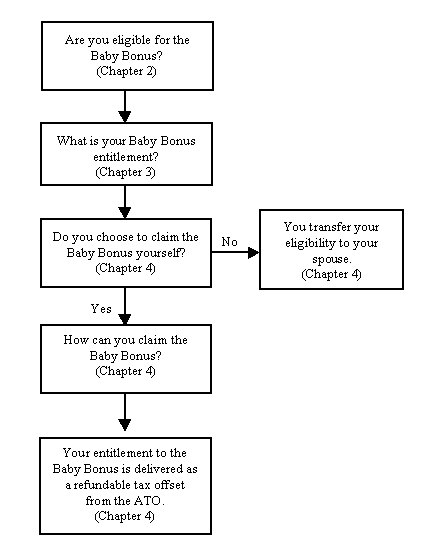Explanatory Memorandum
(Circulated by authority of the Treasurer, the Hon Peter Costello, MP)Chapter 1 - An overview of the Baby Bonus
Outline of chapter
1.1 This chapter provides a general overview of the Baby Bonus. It briefly explains each component of the Baby Bonus and refers readers to the relevant chapters for a more detailed explanation of the rules. Diagram 1.1 shows how the Baby Bonus rules relate to each other.

Context of reform
1.2 The object of the Baby Bonusis to recognise the loss of income that generally follows the arrival of a familys first child. The Treasurer, in his Press Release No. 89 of 28 October 2001, stated:
"One of the hardest times for families, financially, comes on the birth of a first child. Typically, a family loses one of its two incomes for a period of time as the primary carer (usually the mother) gives up, or reduces, her paid employment to care for her child."
The Baby Bonus is designed to pay back to mothers the tax paid on their income (up to a limit) in the year prior to the birth of the child.
1.3 The measure applies to assessments for the 2001-2002 income year and later income years. As a transitional measure, the Baby Bonus is also available to families who already have children. The way in which the transitional measure is given effect is for the Baby Bonus to be available in respect of the first child born on or after 1 July 2001, whether or not it is the couples first child.
Summary of new law
1.4 The repayment of tax will occur over a maximum period of 5 years with a maximum entitlement of $2,500 per year. To ensure that low income earners (those with a taxable income of $25,000 or less in the claim year) and those who were not in the workforce also benefit from the measure, a minimum entitlement of $500 per year will be available. For the purposes of this explanatory memorandum the claim year is the year of income for which the claim relates.
1.5 The Baby Bonus is available to mothers who give birth on or after 1 July 2001 and to a person who adopts or otherwise obtains legal responsibility for a child on or after 1 July 2001.
1.6 A person may choose to transfer their entitlement to the Baby Bonus to their spouse.
1.7 Taxpayers will be able to make a claim for the Baby Bonus as part of their annual income tax return process. People who are not required to lodge tax returns will be able to claim the Baby Bonus by lodging a claim form with the ATO.
Detailed explanation of new law
Eligibility for the Baby Bonus - Chapter 2
1.8 The Baby Bonus is available to:
- •
- mothers who give birth to their first child on or after 1 July 2001;
- •
- a person who adopts their first child on or after 1 July 2001 and the child is under 5 years of age;
- •
- a person who otherwise obtains legal responsibility for their first child on or after 1 July 2001 and the child is under 5 years of age; or
- •
- a person to whom the entitlement to the Baby Bonus has been transferred.
Entitlement to the Baby Bonus - Chapter 3
1.9 The Baby Bonus is available to a person who has suffered a reduction in taxable income after gaining legal responsibility for a child on or after 1 July 2001.
1.10 The Baby Bonus entitlement is calculated by comparing a persons taxable income in the base year (usually the year before gaining legal responsibility of the child) to the taxable income in the claim year.
1.11 Gross tax paid by a person in the base year is spread evenly over a maximum period of 5 years. This annual amount, which cannot exceed $2,500, is the maximum Baby Bonus available until the child turns 5 years of age.
1.12 A minimum entitlement of $500 is available to people with taxable income of $25,000 or less.
Claiming and payment of the Baby Bonus - Chapter 4
1.13 The Baby Bonus is available as a refundable tax offset.
1.14 A person may make a claim for the Baby Bonus as part of their annual income tax return process.
1.15 A person can only make one claim for the Baby Bonus each year.
1.16 A person may choose to transfer, on a yearly basis, their entitlement to claim the Baby Bonus to their spouse.
1.17 The Baby Bonus will be administered by the ATO and will form part of a persons annual income tax assessment notice. This means that it may increase a persons tax refund or reduce a persons tax debt.
1.18 The Baby Bonus will be applied (where applicable) to reduce a persons:
- •
- tax debts;
- •
- Family Tax Benefit debts;
- •
- Child Support Agency debts; and
- •
- other tax related Commonwealth debts.
1.19 People who are not required to lodge income tax returns will receive their entitlement to the Baby Bonus from the ATO by completing a separate claim form. This will effectively create a nil income tax assessment with the Baby Bonus as a refundable tax offset. An entitlement claimed by lodging a separate claim form may still be applied against other tax related debts.
